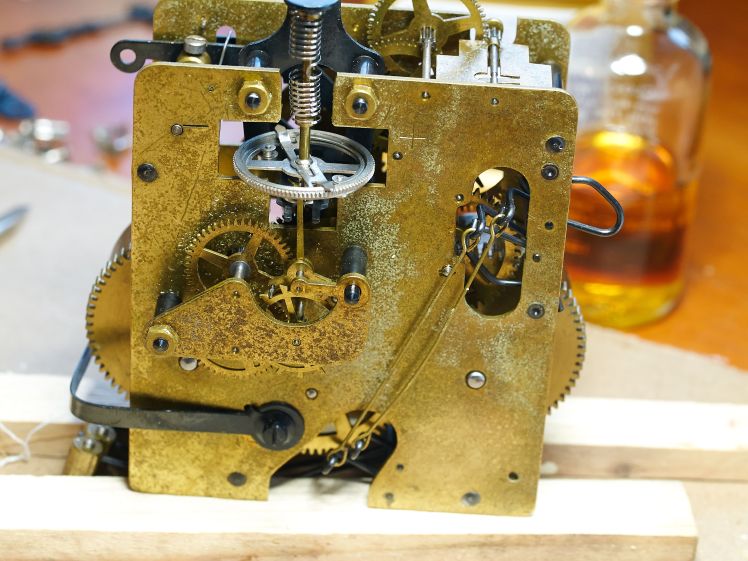In a precious article I wrote about my frustrations getting this clock to run reliably. No matter what adjustments I made it ran poorly.
“You’ve got to be very careful if you don’t know where you are going, because you might not get there”, Yogi Berra
This time and strike movement (Hermle?) has been out of its case and lying in drawer for the past year or so. When I met the seller in a parking lot some time ago as I handed him $20 for this Dugena mantel clock he climbed into his car he said, “I hope you don’t expect much for $20; it’s not perfect”. Well, it’s not perfect.
It was keeping poor time, losing an hour or so a day but I thought, what a great clock to practice on and practice I did.
Oiling the movement had no effect. Issues? A weak spiral spring, a worn jewel on the floating balance, a power issue associated with a weak mainspring or perhaps pivot wear. I disassembled the movement several times and serviced the mainsprings. I had an issue re-hooking the strike side mainspring and so, discouraged, I put it aside.

Dugena – is it a clock company?
Dugena was a German retail clock name only, a marketing name, not a maker of movements or cases. Dugena was a registered cooperative society, a “Genossenschaft”, that bought clocks from other makers to sell them under their own brand. A brand name for a retail chain more or less.


Floating balance clocks are much more accurate and above all, they do not have have the disadvantage of the pendulum; these clocks work even when the case is at an oblique angle
A great invention – the floating balance
The floating balance movement in this clock could have been made by anyone; Urgos, Jauch or Hermle perhaps. Hermle is likely since it was one of the leading companies using the floating balance escapement. The floating balance was invented in the 1930s but it took till 1941 for the patent application to be registered. It took another 10 years after that for the patent to be granted slowed by the war years and the challenges of industry recovery following the Second World War.
The floating balance was a great invention. Floating balance clocks are generally more accurate and above all, they do not have have the main disadvantage of the pendulum; they will work even when the clock case is at an oblique angle.

Back to the the clock
Months passed. I took the movement out, looked at the strike side barrel a second time, popped the barrel cap off and using pliers gave the inner part of the mainspring a turn and it hooked onto the catch. Success at last. The mainspring barrels can be removed without dis-assembly of the movement, so, in it went. Despite my minor triumph with the strike-side mainspring, straightening the spiral spring and adjusting the balance wheel to its fastest set point, the clock ran only marginally better. The only consolation is that although it runs 5 minutes slower per day it runs a full eight day cycle.
Despite the minor disappointment it has been a productive learning experience but I am inclined to put it aside as I have other projects on the go. Every time I think about the issues I am having with this clock it always comes back to the balance wheel.
Some day the solution will pop into my head.

Hello there! I know this is kinda off topic but I’d figured I’d ask. Would you be interested in trading links or maybe guest authoring a blog article or vice-versa? My website covers a lot of the same subjects as yours and I feel we could greatly benefit from each other. If you might be interested feel free to shoot me an email. I look forward to hearing from you! Wonderful blog by the way!
LikeLike
Give a link to your site and we will see.
LikeLike
Excellent post. Keep posting such kind of information on your page. Im really impressed by your site.
LikeLike
Thanks for coming to my blog.
LikeLike
Love a bit of horology one day I might learn some. Beautiful photos too!
LikeLiked by 1 person
Thanks for dropping by and for following my blog.
LikeLiked by 1 person
Great post Thanks for sharing.
LikeLike
Thanks
LikeLike
After checking out a handful of the blog articles on your web site, I honestly appreciate your way of writing a blog. I added it to my bookmark website list and will be checking back soon. Take a look at my web site too and tell me how you feel.
LikeLike
Thanks
LikeLike
This is my first time pay a quick visit at here and i am really happy to read everthing at one place.
LikeLike
Thanks
LikeLike
This piece of writing will assist the internet visitors for creating new webpage or even a blog from start to end.
LikeLike
Thanks
LikeLike
Your style is very unique compared to other folks I’ve read stuff from. Many thanks for posting when you’ve got the opportunity, Guess I will just book mark this blog.
LikeLike
Thanks
LikeLike
lol nice, thanks
LikeLike
Thanks
LikeLike
On your clock, check to see if the banking pins have been messed with. They may be too far apart, making the clock run slow. Moving them ever so slightly closer together will speed the clock.
LikeLike
Good point, I will check that. Thanks.
LikeLike